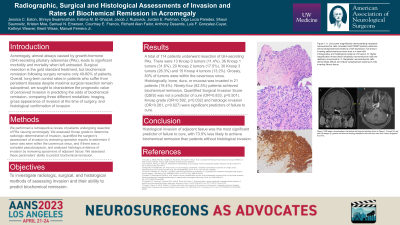Radiographic, Surgical and Histological Assessments of Invasion and Rates of Biochemical Remission in Patients with Acromegaly
Friday, April 21, 2023


Jessica C. Eaton, MD (she/her/hers)
Neurological Surgery Resident
University of Washington
Seattle, Washington, United States
ePoster Presenter(s)
Introduction: Acromegaly, caused by growth hormone (GH)-secreting pituitary neuroendocrine tumors (PitNETS), leads to significant morbidity and mortality if left untreated, with remission rates following resection only 40%-60%. We compared three modalities of assessing invasion for prognostic value: imaging, gross appearance at the time of surgery, and histological confirmation.
Methods: We performed a retrospective review of patients undergoing resection of PitNETs causing acromegaly. Knosp grade was assessed by evaluating pre-operative MRI. We quantified the surgeon’s assessment of invasion by recording if tumor was grossly seen within the cavernous sinus or other adjacent tissues, and the completeness of tumor pseudocapsule. These were scored and summed to create the Quantified Surgical Invasion (QSI). Histologic evidence of invasion was then assessed by reviewing specimens of adjacent tissue. We performed 3 multivariate analyses controlling for age, sex, and tumor volume and assessing Knosp grade vs QSI vs histologic invasion as predictors of cure.
Results: A total of 114 patients underwent resection of GH-secreting PitNETs during the study period. There were 13 Knosp 0 tumors (11.4%), 36 Knosp 1 tumors (31.6%), 20 Knosp 2 tumors (17.5%), 30 Knosp 3 tumors (26.3%) and 15 Knosp 4 tumors (13.2%). Grossly, 83% of tumors were within the cavernous sinus. The pseudocapsule was incomplete in 20.5% of tumors and absent in 25.9% of tumors. Histologically, bone, dura, or mucosa was invaded in 21 patients (18.4%). 94 (82.5%) patients achieved remission. Knosp grade and histologic invasion were associated with lower cure rate. QSI was not a predictor of cure. In multivariate models, QSI was not a predictor (OR=0.833, p=0.501). Knosp grade (OR=0.592, p=0.032) and histologic invasion (OR=0.261, p=0.027) were significant predictors of failure to cure.
Conclusion : Histological invasion was the most significant predictor of failure to cure. Patients with invasion were 73.9% less likely to achieve biochemical remission than those without.
Methods: We performed a retrospective review of patients undergoing resection of PitNETs causing acromegaly. Knosp grade was assessed by evaluating pre-operative MRI. We quantified the surgeon’s assessment of invasion by recording if tumor was grossly seen within the cavernous sinus or other adjacent tissues, and the completeness of tumor pseudocapsule. These were scored and summed to create the Quantified Surgical Invasion (QSI). Histologic evidence of invasion was then assessed by reviewing specimens of adjacent tissue. We performed 3 multivariate analyses controlling for age, sex, and tumor volume and assessing Knosp grade vs QSI vs histologic invasion as predictors of cure.
Results: A total of 114 patients underwent resection of GH-secreting PitNETs during the study period. There were 13 Knosp 0 tumors (11.4%), 36 Knosp 1 tumors (31.6%), 20 Knosp 2 tumors (17.5%), 30 Knosp 3 tumors (26.3%) and 15 Knosp 4 tumors (13.2%). Grossly, 83% of tumors were within the cavernous sinus. The pseudocapsule was incomplete in 20.5% of tumors and absent in 25.9% of tumors. Histologically, bone, dura, or mucosa was invaded in 21 patients (18.4%). 94 (82.5%) patients achieved remission. Knosp grade and histologic invasion were associated with lower cure rate. QSI was not a predictor of cure. In multivariate models, QSI was not a predictor (OR=0.833, p=0.501). Knosp grade (OR=0.592, p=0.032) and histologic invasion (OR=0.261, p=0.027) were significant predictors of failure to cure.
Conclusion : Histological invasion was the most significant predictor of failure to cure. Patients with invasion were 73.9% less likely to achieve biochemical remission than those without.
